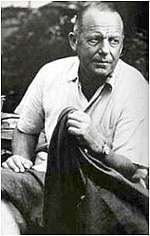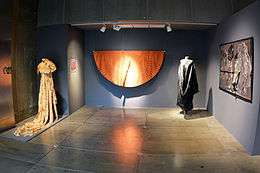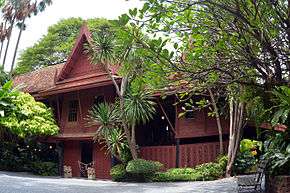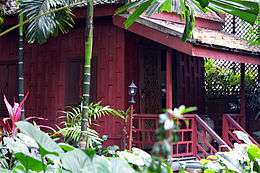Jim Thompson (designer)
| Jim Thompson | |
|---|---|
 | |
| Born |
James Harrison Wilson Thompson 21 March 1906 Greenville, Delaware, United States of America |
| Disappeared |
26 March 1967 (aged 61) Cameron Highlands, Pahang, Malaysia. |
| Status | Declared dead in absentia by a Thai court in 1974 |
| Citizenship | American |
| Alma mater |
Princeton University University of Pennsylvania |
| Occupation | Co-founder of the Thai Silk Company Limited |
| Known for |
|
| Spouse(s) |
Patricia Maury Thraves (1943-1946; divorced) |
| Parent(s) |
Henry Burling Thompson (father) Mary Wilson Thompson (mother) |
James Harrison Wilson Thompson (born 21 March 1906 — disappeared 26 March 1967) was an American businessman who helped revitalise the Thai silk industry in the 1950s and 1960s. At the time of his disappearance he was one of the most famous Americans living in Asia. Time magazine claimed he "almost singlehanded(ly) saved Thailand's vital silk industry from extinction".[1] His disappearance from the Cameron Highlands generated one of the largest land searches in Southeast Asian history, and is one of the most famous mysteries in the region.
Early life
Jim Thompson was born in Greenville, Delaware, USA. [2] He was the youngest of five children of Henry and Mary Thompson. His father was a wealthy textile manufacturer; his mother was the daughter of James Harrison Wilson (1837–1925), a noted Union general during the American Civil War. [3]
Thompson spent his early years of education at St. Paul's School. He graduated from Princeton University in 1928, [4] and represented the United States in the 6-Metre Sailing event at the 1928 Summer Olympics in Amsterdam, the Netherlands. [5] Post-graduate studies followed at the University of Pennsylvania's School of Architecture, but he did not complete his degree at this institution due to his weakness in calculus. [6]
From 1931 to 1940, he practised in New York City with Holden, McLaughlin & Associates, [7] designing homes for the East Coast rich and a band shell in Rehoboth Beach, Delaware. His blueprints were reviewed and signed off by certified architects.
Throughout the 1930s, Thompson led an active social life and sat on the board of the Ballet Russe de Monte Carlo. [8]
In 1941, he quit his job and enlisted with the Delaware National Guard. [9] Before the outbreak of the Second World War, he was transferred to a military outpost in Fort Monroe, Virginia. [10] While he was here, he got to know Second Lieutenant Edwin Fahey Black, a fresh graduate from the US Military Academy, West Point. [11] It was Black who encouraged him to join the Office of Strategic Services (OSS), the forerunner of the Central Intelligence Agency.[12]
World War II activities
At the height of the Second World War, Thompson was recruited by major general William Joseph Donovan (1883–1959) to serve as an operative in the OSS.
His first assignment was with the French Resistance in North Africa. He was then sent to Europe. After Victory in Europe Day (7–8 May 1945), he was transferred to Ceylon (now Sri Lanka) to work with the pro-Allied Seri Thai or Free Thai Movement. Their mission was to help liberate Thailand from the occupying Japanese Army. The group had the support of Pridi Panomyong, the regent to King Ananda Mahidol of Thailand and Seni Pramoj, the Thai ambassador to the United States.
In August 1945, Thompson was about to be sent into Thailand, when the Surrender of Japan officially ended World War II. He arrived in Thailand shortly after Victory over Japan Day and organised the Bangkok OSS office. It was here he got to know Mrs. Constance (Connie) Mangskau, an Allied Services translator, who later became one of his closest friends.
In the spring of 1946, Thompson went to work as military attaché at the United States legation for his former Princeton classmate Charles Woodruff Yost, the US Minister to Thailand. Thompson used his contacts with the Free Thai and Free Lao groups to gather information and defuse conflicts on Thailand's borders. Working with him in the Legation was Kenneth Landon, an American missionary [13] whose wife, Margaret Landon, was the author of Anna and the King of Siam, which was the inspiration for a 1946 drama of the same name, and The King and I in 1956.
Return to private industry
In late 1946, Thompson headed for home to seek his discharge from the army. After his divorce from Patricia Thraves (1920-1969), he returned to Thailand to join a group of investors to buy The Oriental Hotel in Bangkok. While working on its restoration, he had some differences with his associates and this resulted in him giving up his shares. He subsequently switched his focus to silk.

In 1948,[14] he partnered with George Barrie to found the Thai Silk Company Limited. It was capitalised at US$25,000. They each bought eighteen percent of the shares. The remaining sixty-four percent were sold to Thai and foreign investors.
The firm achieved a coup in 1951 when designer Irene Sharaff made use of Thai silk fabrics for the Rodgers and Hammerstein musical, The King and I. From then on, the company prospered.
Besides inventing the bright jewel tones and dramatic colour combinations today associated with Thai silk, Thompson raised thousands of Thailand's poorest people out of poverty. His determination to keep his company cottage-based was significant for the women who made up the bulk of his work force. By allowing them to work at home, they retained their position in the household while becoming breadwinners. It was only after Thompson's disappearance that the Thai Silk Company relocated its weaving operations to Korat, a city which serves as a base of operations for the Royal Thai Army. Although it abandoned home-based weaving in favour of factories in the early 1970s, the Thai Silk Company's Korat facility looks more like a landscaped campus than a factory.
Thompson's "House on the Klong"

Thompson was unlike any other figure in Southeast Asia. He was an American, an ex-architect, a retired army officer, a one-time spy, a silk merchant and a renowned collector of antiques. Most of his treasures, if not all, were amassed after he came to Thailand.
In 1958, he began what was to be the pinnacle of his architectural achievement – the construction of a new home to showcase his objets d'art.

Using parts of old up-country houses – some as old as a hundred years – he succeeded in constructing a masterpiece that involved the reassembling of six Thai dwellings on his estate. Most of the units were dismantled and brought over by river from Ayutthaya, but the largest – a weaver's house (now the living room) – came from Bangkrua. On arrival, the woodwork was offloaded and pieced together.

In his quest for authenticity, he saw to it that some of the structures were elevated a full floor above the ground. During the construction stage, he added his own touches to the buildings by positioning, for instance, a central staircase indoors rather than having it outside. Along the way, he also reversed the wall panels of his quarters so that it now faced inside instead of it having an external orientation.[15]
After he was through with its creation, he filled his home with the items he had collected in the past. Decorating his rooms were Chinese blue-and-white Ming pieces, Belgian glass, Cambodian carvings, Victorian-era chandeliers, Benjarong earthenware, Thai stone images, Burmese statues, and a dining table which was once used by King Rama V of Thailand.
It took Thompson almost a year to complete his mansion. Now a museum, the Jim Thompson House can be reached by public or private transport.
Disappearance
Thompson disappeared from Malaysia's Cameron Highlands [16] on Sunday, 26 March 1967. For further details, see: Disappearance of Jim Thompson.
See also
References
- ↑ "Business Abroad: The Silk King, Time, Monday, 21 April 1958".
- ↑ "Jim Thompson: A legend is born".
- ↑ "A brief history of Jim Thompson". jimthompson.com.
- ↑ "The Architect Who Changed the Thai Silk Industry and Then Disappeared". Time.
- ↑ "Jim Thompson Bio, Stats, and Results". Olympic Sports. Sports-Reference.com. Archived from the original on 23 May 2015. Retrieved 18 March 2015.
- ↑ "Jim Thompson, the Thai Silk King" (PDF). Penn Museum.
- ↑ "HOLDEN New York Stories/Jim Thompson". Holden - Jim Thompson Fabrics.
- ↑ "A brief history of Jim Thompson". jimthompson.com.
- ↑ "The Architect Who Changed the Thai Silk Industry and Then Disappeared". Time.
- ↑ Warren, William (1998). Jim Thompson - The unsolved mystery. Archipelago Press. p. 39. ISBN 981-3018-82-8.
- ↑ Warren, William (1998). Jim Thompson - The unsolved mystery. Archipelago Press. p. 39. ISBN 981-3018-82-8.
- ↑ De Souza, Edward Roy (2010). SOLVED! The "Mysterious" Disappearance of Jim Thompson, the Legendary Thai Silk King (2nd ed). Word Association Publishers. p. 3. ISBN 978-1-59571-505-0. LCCN 2009944204.
- ↑ The American largely responsible for bringing about this relationship was Dr. Kenneth Landon, a former Presbyterian minister who had spent ten years in Thailand as a missionary. Archived 17 March 2013 at WebCite
- ↑ "The Thai Silk Company Founded in 1948,". The Jim Thompson House. Archived from the original on 6 March 2016. Retrieved 19 June 2016.
- ↑ De Souza, Edward Roy (2010). SOLVED! The "Mysterious" Disappearance of Jim Thompson, the Legendary Thai Silk King (2nd ed). Word Association Publishers. pp. 13–14. ISBN 978-1-59571-505-0. LCCN 2009944204.
- ↑ "Cameron Highlands, Pahang, Malaysia Google map". Google Inc. Retrieved 9 April 2018.
Books
- De Souza, Edward Roy (2010). SOLVED! The "Mysterious" Disappearance of Jim Thompson, the Legendary Thai Silk King (2nd ed). Word Association Publishers. ISBN 978-1-59571-505-0. LCCN 2009944204.
- Warren, William (1970). The Legendary American: The Remarkable Career and Strange Disappearance of Jim Thompson. Houghton Mifflin. ISBN 978-0-395-08302-4.
- Warren, William (1998). Jim Thompson: The Unsolved Mystery. ISBN 978-981-3018-82-2.
- Kurlantzick, Joshua (2011). The Ideal Man : The Tragedy of Jim Thompson and the American Way of War. Hoboken, NJ: John Wiley and Sons. ISBN 978-0-470-08621-6. Lay summary (8 November 2011).
Video
- Legendary Locations S01 - Ep03 Lost and Found www.YouTube.com
- Anderson, Hope (director) (2001, 2004). Jim Thompson, Silk King (VHS, DVD). Hope Anderson Productions.
- Anderson, Hope (director) (2004). The Jim Thompson House and Art Collection (VHS). Hope Anderson Productions.
News articles
- "Business Abroad: The Silk King". Time Magazine. 21 April 1958. Retrieved 4 January 2013.
- "Millions from the Mulberry Bush". Time Magazine. 16 July 1965. Retrieved 25 March 2007.
- "American 'Silk King of Thailand' Disappears in Malaysian Jungle". Washington Post, Times Herald. 28 March 1967. pp. A12. Retrieved 25 March 2008.
- "American 'Silk King' Vanishes on Stroll in Malaysian Jungle". Los Angeles Times. 28 March 1967. p. 1. Retrieved 25 March 2007.
- "A Walk in the Jungle". Time Magazine. 7 April 1967. Retrieved 15 March 2007.
- "Air of Intrigue". Time Magazine. 5 May 1967. Retrieved 25 March 2007.
- "Mystery of missing Thai Silk King". BBC News. 25 March 2007. Retrieved 25 March 2007.
- "Looking for the Silk King". The Star. 23 March 2010. Archived from the original on 30 October 2012. Retrieved 23 September 2010.
- "Bones May Cast Some Light to Jim Thompson's Mystery". Ipoh Echo. 1 April 2010. Retrieved 28 September 2010.
- "Re-living the day Jim Thompson went missing". The Star. 26 March 2012. Archived from the original on 13 April 2013. Retrieved 24 March 2013.
- "Cameron Highlands: Malaysia's enduring 'Little England'". CNN Travel. 27 June 2013. Retrieved 3 July 2013.
- "Cloaked in mist and mystery". New Straits Times. 4 December 2014. Retrieved 7 December 2014.
- Toulmin, Llewellyn. "The Exotic Life and Death of Thailand's 'Silk King,'" The Montgomery Sentinel (Montgomery County, Maryland), May 7, 2015, p. 19 (part 1 of a 4-part series).
- Toulmin, Llewellyn. "The Mysterious Disappearance and Search for Jim Thompson" The Montgomery Sentinel (Montgomery County, Maryland), June 4, 2015, p. 16 (part 2 of a 4-part series).
- Toulmin, Llewellyn. "Continuing the Search for the 'Silk King'" The Montgomery Sentinel(Montgomery County, Maryland), July 2, 2015, p. 19 (part 3 of a 4-part series).
- Toulmin, Llewellyn. "The Last Stop in the Search for Jim Thompson" The Montgomery Sentinel (Montgomery County, Maryland), August 6, 2015, p. 19 (part 4 of a 4-part series).
- "The Architect Who Changed the Thai Silk Industry and Then Disappeared". Time Magazine. 9 May 2016. Retrieved 2 June 2016.
- "New film sheds light on Jim Thompson mystery". Bangkok Post. 21 October 2017. Retrieved 22 October 2017.
- "New film 'solves' Jim Thompson mystery". The Australian. 21 October 2017. Retrieved 22 October 2017.
- "New film claims to have solved Jim Thompson mystery". Bluefield Daily Telegraph. 21 October 2017. Retrieved 22 October 2017.
- "Jim Thompson was killed by Malay communists, sources say". The Nation (online). 5 December 2017. Retrieved 6 December 2017.
- "Theory Jim Thompson was killed by communists plausible, but not new". The Nation (online). 6 December 2017. Retrieved 6 December 2017.
External links
| Wikimedia Commons has media related to Jim Thompson (designer). |
- Jim Thompson House
- Jim Thompson, the Thai Silk King www.YouTube.com
- Jim Thompson – Thai Silk King by Clem McMurray
- Jim Thompson – The Mystery by Carrado Jay Boccia
- Jim Thompson, The Unsolved Mystery by William Warren
- Silk Thread: The Strange Mystery of Jim Thompson by Larry Wallace
- Bangkok, Thailand and the unsolved mystery of Jim Thompson by Bob Taylor
- The Curious Case of Jim Thompson, Thai Silk King by Kenneth Champeon
- The Unexplainable Disappearance of Jim Thompson, Thai Silk King by Catherine Phelan
- Tracking the Legend: My Search for Jim Thompson by Francine Matthews, former CIA agent
- Solved! The disappearance of Jim Thompson in the Cameron Highlands by Edward Roy De Souza
- http://www.themosttraveled.com/new/new_land.html (link to search and rescue report on Jim Thompson's disappearance by Toulmin)
